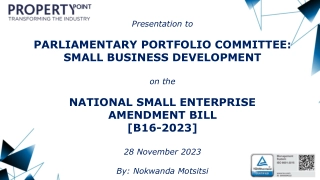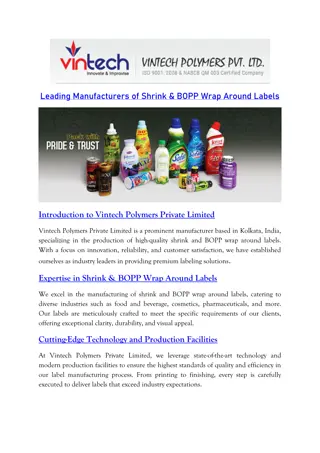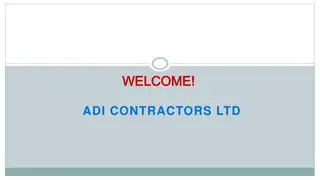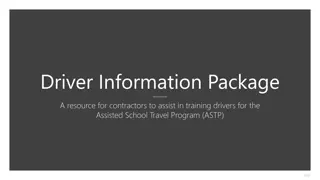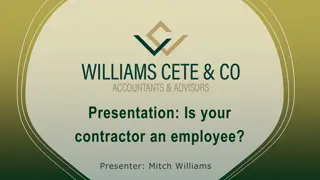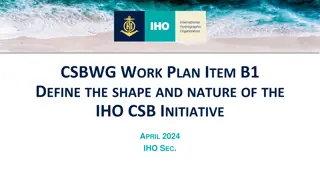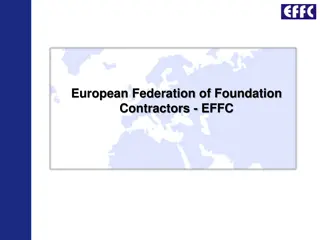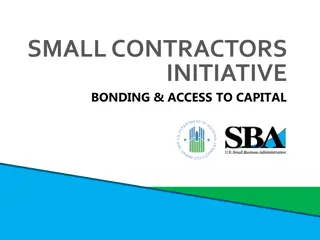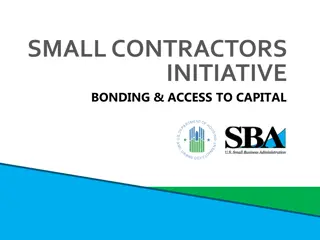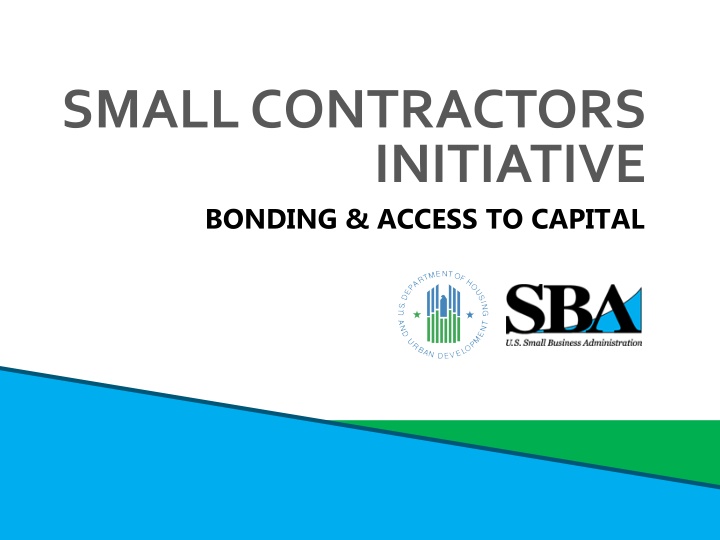
Initiative for Small Contractors: Bonding and Access to Capital
Explore the challenges faced by small construction contractors in accessing capital and bonding, including how to demonstrate continuing capacity and achieve goals. Gain insights on strategic management, planning ahead, and preparing action plans to enhance your business.
Uploaded on | 3 Views
Download Presentation

Please find below an Image/Link to download the presentation.
The content on the website is provided AS IS for your information and personal use only. It may not be sold, licensed, or shared on other websites without obtaining consent from the author. If you encounter any issues during the download, it is possible that the publisher has removed the file from their server.
You are allowed to download the files provided on this website for personal or commercial use, subject to the condition that they are used lawfully. All files are the property of their respective owners.
The content on the website is provided AS IS for your information and personal use only. It may not be sold, licensed, or shared on other websites without obtaining consent from the author.
E N D
Presentation Transcript
SMALL CONTRACTORS INITIATIVE BONDING & ACCESS TO CAPITAL
SMALL CONTRACTORS INITIATIVE SESSION 8 WRAP-UP
SESSION OVERVIEW Introduction Part A: Continuing Capacity Achieving Goals Planning Ahead Strategic Management Examples of Goals Analysis and When to Make Changes Exercise Resources Part B: Pulling it all Together Final Questions Action Plans Achievements: Bondable? Working Capital Loan? What Steps Remain? Where to Go for Help? How far Have I Come? Course Evaluation U.S. Dept. of Housing and Urban Development U.S. Small Business Administration 3
INTRODUCTION This session will focus on realizing the plans you have developed. Part A focuses on how to demonstrate a continuing capacity to perform. Part B focuses on final preparations, including seeing how far you have come during the course. U.S. Dept. of Housing and Urban Development U.S. Small Business Administration 4
PART A: CONTINUING CAPACITY U.S. Dept. of Housing and Urban Development U.S. Small Business Administration 5
PART A: LEARNING OBJECTIVES 1. Understand how to be prepared for challenges and inspire the confidence of bonding agents and loan officers. 2. Gain knowledge to continue planning through the current job and beyond. U.S. Dept. of Housing and Urban Development U.S. Small Business Administration 6
CHALLENGES IN ACHIEVING GOALS Construction contractors face numerous challenges that impede performance: Skilled labor. Cashflow. Administrative support. Forces of nature. Bond agents and loan officers know this. Getting bonded or accessing capital does not always ensure continuing capacity to perform questions remain. U.S. Dept. of Housing and Urban Development U.S. Small Business Administration 7
QUESTIONS Do you have the capacity to implement your plans after getting bonded or accessing capital? Current contract. Those to come. How will you achieve your goals when challenged? Can you convince bond agents/lenders that you are prepared? U.S. Dept. of Housing and Urban Development U.S. Small Business Administration 8
PLANNING AHEAD To deal with challenges, successful contractors use proven business techniques: Manage strategically. Track progress. Analyze results. Decide to change direction (contingency planning). Take action. Keep lines of communication open. Bond agents. Loan officers. U.S. Dept. of Housing and Urban Development U.S. Small Business Administration 9
STRATEGIC MANAGEMENT AT A GLANCE PLANNING Set reasonable goals, and have a clear plan and timeline for attaining them. DECISION MAKING Adjust the allocation of resources as needed and modify the goals and timetable. INFORMATION Keep track of your progress. ACTION Implement the updated plans with an eye on overcoming the obstacles. EVALUATION Identify problems and figure out why they are happening. STRATEGIC MANAGEMENT HAPPENS EVERY DAY! U.S. Dept. of Housing and Urban Development U.S. Small Business Administration 10
THE STRATEGIC MANAGEMENT CYCLE IMPLEMENT ACTION PLANS ADJUST ACTION PLANS MONITOR ACTION PLANS EVALUATE ACTION PLANS U.S. Dept. of Housing and Urban Development U.S. Small Business Administration 11
EXAMPLES OF GOALS FINANCIAL CAPACITY INTERNAL SYSTEMS MARKETING CONSTRUCTION CONTRACTING Enhance estimating and job management. Obtain certifications. Improve financial management systems and practices. Increased working capital and bonding. Growth in sales and profits. Pursue more bid opportunities with more success. Add or expand skills and competencies. Add equipment and other resources. U.S. Dept. of Housing and Urban Development U.S. Small Business Administration 12
TRACKING PROGRESS Information systems are key. Timely reports. Make sure you get the information you need. U.S. Dept. of Housing and Urban Development U.S. Small Business Administration 13
ANALYSIS Identify problem areas. Trouble shooting Why is this happening? Is there time to get back on track? U.S. Dept. of Housing and Urban Development U.S. Small Business Administration 14
DECIDING WHEN TO MAKE CHANGES Where are changes needed? Allocation of resources (human, equipment, financial). Adjust goals to be more realistic. Update What if? contingency planning, based on recent experience. Bring other stakeholders on board with the changes. Management team. Owners. Bonding agent. Lender. U.S. Dept. of Housing and Urban Development U.S. Small Business Administration 15
TAKE ACTION Clear action plans: Specific steps. Assign responsibility. Set timelines. Notify other stakeholders. Adjust cashflow and revenue projections. Implement the changes. U.S. Dept. of Housing and Urban Development U.S. Small Business Administration 16
EXERCISE Small Group Exercise: Three to four participants work together. Each group is given a sample problem. Results are presented to the entire cohort. U.S. Dept. of Housing and Urban Development U.S. Small Business Administration 17
TAKEAWAY Small organizations needs to be agile, adaptable, and flexible enough to develop new strengths and capture niche opportunities within a competitive industry, often with bigger players. Strategies often incorporate flexibility to capture new opportunities as they arise. U.S. Dept. of Housing and Urban Development U.S. Small Business Administration 18
KEYS TO IMPLEMENTATION Keep everyone aware of goals and plans for achieving them. Regular progress updates for management that compare results to projections. Communicate concerns and work together on ways to address issues. Maintain a clear Action List, assign specific tasks and timelines, and keep on top of it. U.S. Dept. of Housing and Urban Development U.S. Small Business Administration 19
RESOURCES These links provide additional information: Davidson & Maguire, Ten Most Common Causes of Construction Contractor Failures, 2003. Lumen Learning, Strategic Management, Boundless Management. U.S. Dept. of Housing and Urban Development U.S. Small Business Administration 20
PART B: PULLING IT ALL TOGETHER U.S. Dept. of Housing and Urban Development U.S. Small Business Administration 21
PART B: LEARNING OBJECTIVES 1. Identify areas that need more work and support. 2. Acknowledge accomplishments and progress through participation in this training. U.S. Dept. of Housing and Urban Development U.S. Small Business Administration 22
FINAL QUESTIONS What have I achieved? Am I now bondable ? Can I get a working capital loan? What steps remain? Where will I get help? U.S. Dept. of Housing and Urban Development U.S. Small Business Administration 23
ACTION PLANS: A LAST LOOK Participants review their company s action plan 5 minutes. Using examples from participants, the group discusses the questions on slide 23. U.S. Dept. of Housing and Urban Development U.S. Small Business Administration 24
WHAT HAVE I ACHIEVED? Mark it as DONE, for now. Example Certification as a small business DONE. But the work is not coming in, so consider seeking other certifications. These will still need to be revisited. Example Obtain bonding for current job DONE. But to get bonding for larger jobs, I will need to add to my working capital. U.S. Dept. of Housing and Urban Development U.S. Small Business Administration 25
AM I NOW BONDABLE? If yes, for what level? Prequalified? Identified an agent to work with? Yes, we have a bond in place! U.S. Dept. of Housing and Urban Development U.S. Small Business Administration 26
WORKING CAPITAL LOAN? If yes, for what amount? Qualified? Identified an lender to work with? Yes, we have been approved for a loan! U.S. Dept. of Housing and Urban Development U.S. Small Business Administration 27
WHAT STEPS REMAIN? Completing items on the action plan. Submitting forms and documents to the agent. Satisfying working capital needs. Getting bonded for an actual contract. U.S. Dept. of Housing and Urban Development U.S. Small Business Administration 28
WHERE TO GO FOR HELP? Consultants CPA, attorney. Bonding agent. Loan officer. SBA website. Local organization SBDC. U.S. Dept. of Housing and Urban Development U.S. Small Business Administration 29
HOW FAR HAVE I COME? Take the self-assessment. How much has your knowledge grown since starting this course? The results will be compared to the self- assessment you completed before the course. U.S. Dept. of Housing and Urban Development U.S. Small Business Administration 30
COURSE EVALUATION Did this course meet your needs? Was the material helpful? Were the facilitators and mentors helpful? Please complete the course evaluation form and turn it in before leaving. U.S. Dept. of Housing and Urban Development U.S. Small Business Administration 31
THANK YOU! BEST WISHES IN GROWING YOUR BUSINESS U.S. Dept. of Housing and Urban Development U.S. Small Business Administration 32

